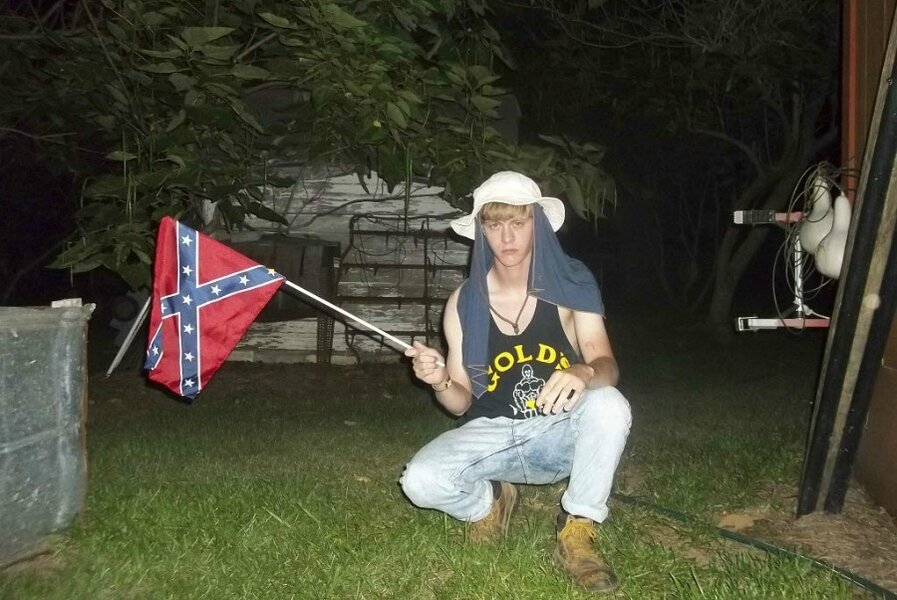Beyond Rhodesia, Dylann Roof's manifesto and the website that radicalized him
Loading...
That Dylann Storm Roof, the man who allegedly killed nine black parishioners at a Bible study meeting at the historic Emanuel African Methodist Episcopal church in Charleston, SC, had a fondness for the white apartheid government of Rhodesia was already clear.
So it was hardly a surprise when a website was uncovered that was almost certainly controlled by Mr. Roof (it contains dozens of pictures of him) and that its name is "The Last Rhodesian." The pictures tell a story of their own, and one far beyond his affection for white-ruled southern Africa.
Roof, his scrawny arms sometimes poking out of a Gold's Gym singlet, other times wearing a shirt emblazoned with "88" (a popular number among neo-Nazi’s since "h" is the eighth letter of the alphabet – code for "Heil Hitler") and at others wearing his jacket with the flags of apartheid Rhodesia and South Africa, appears to have been touring sites connected to slavery and the Confederacy.
Always scowling, there's Roof posing with mannequins of black slaves at what looks to be a plantation museum in the south; Roof holding a Confederate flag in one hand, a Glock .45 in the other; a shirtless Roof pointing the Glock at the camera; Roof burning a small American flag and grinding his Timberland boots into a larger one; pictures of slave quarters on an old plantation; posing outside the Confederate Library and History Museum in Greenville SC; a visit to a cemetery for confederate war dead; a visit to Sullivan's Island in SC, which was one of the largest processing centers for African slaves in the US.
At the start of Roof's online manifesto (which seems authentic; the Last Rhodesian site was started this February) he says what – if he was a Muslim terrorist, would almost certainly be described as his "radicalization" process – led to his racial "awakening" was the killing of Trayvon Martin, a black teen, by George Zimmerman in 2012.
"It was obvious that Zimmerman was in the right," the statement, which seems very likely to have been written by Roof, says. "But more importantly this prompted me to type in the words 'black on White crime'; into Google, and I have never been the same since that day. The first website I came to was the Council of Conservative Citizens. There were pages upon pages of these brutal black on White murders. I was in disbelief. At this moment I realized that something was very wrong. How could the news be blowing up the Trayvon Martin case while hundreds of these black on White murders got ignored?"
The false claim that there's an epidemic of unreported black on white murders in the US is a popular one within the far right, and it is extremely seductive for some young men, who at the extremes are pulled to terrorism.
The Council of Conservative Citizens traces its lineage back to the White Citizen's Councils that sprang up to fight desegregation in the South in the 1950s and 1960s. The Southern Policy Law Center says the citizen's councils were far less violent than the Ku Klux Klan (though a member murdered Mississippi civil rights leader Medgar Evers in 1963) and that former US Supreme Court Justice Thurgood Marshall once called them the "uptown Klan."
The CCC itself has members who in the past haven't exactly been delicate about expressing their racism.
In 1999, when the NAACP began agitating for an economic boycott of South Carolina for continuing to fly the Confederate flag over its state house, CCC North Carolina head A.J. Barker told a rally in Columbia SC: "They are trying to destroy our heritage and culture. They are the enemies of God and the enemies of our race, supported by people with baggy pants and earrings in the eyes and noses and other places like in the heart of Africa."
The Southern Poverty Law Center (SPLC), which tracks hate groups in the US, wondered if Roof was influenced by the CCC on June 18.
"According an eyewitness report, the shooter stated, 'You rape our women and you’re taking over our country. And you have to go,' as he was reloading his weapon," the SPLC wrote on its Hatewatch blog. "Lamenting so called 'black on white crime' is a favorite talking point for white nationalists and the shooter’s statements are virtually indistinguishable from a headline from the Council of Conservative Citizens news engine, Top Conservative News."
As long as the manifesto isn't a hoax, we now know that the similarity isn't a coincidence. The website – which was either pulled down by its owners or perhaps subject to a hacking attack early Saturday afternoon – isn't subtle. The site was archived on May 19 at the Wayback Machine.
"Rapper Jay-Z is funding violent protesters in Baltimore and Ferguson," is one headline (which is placed in the sites "race hustlers," "anti-White" and "Black Nationalism" categories). Another asserts "Oakland School Board will no longer suspend students for willful defiance since black students disproportionately engage in willful defiance" is another. Yet others are "NAACP boss calls for end of freedom of speech to ban Confederate symbols," about the North Carolina NAACP leader's supposed "vicious campaign of racial hatred in Chapel Hill" and a report on three muggings in New York's Central Park over a weekend in May that the site calls a "vicious racial mob attack." Those are just from May 12 to May 19.
The website has carried on this style more recently.
I was looking at it this morning before it was taken down, and a report that caught my eye was a story flagged as "protester calls for race war near scene of Charleston massacre," describing it as "shocking rhetoric." If you click view you find YouTube video of Brandon Darby from far-right website Breitbart baiting a black man and a black women at a protest outside Emanuel Church in Charleston on June 19, starting with Mr. Darby suggesting the killer is mentally ill. They disagree and call him a terrorist.
The pair do indeed call Darby a "cracker" and at one point when Darby asks where it will lead, the woman says "race war – us against them." But whoever these folks are – Breitbart has cropped the film so you can't see the poster the man is holding – they're clearly not mainstream. The woman also goes on to criticize the African Methodist Episcopal church, saying "praying to white Jesus ain’t going to save nobody."
Those many black leaders in Charleston calling for calm and a spirit of Christian forgiveness toward Roof in the past few days? No sign of their words were to be found on the site. That doesn't fit their narrative, which in the case of Roof, appears to have led to tragic results.
For the rest of Roof's screed, it's about what you expect. He compares blacks to dogs and other animals, rails against miscegenation, says people of African descent are genetically predisposed to violence and stupidity, muses that there's some "white blood worth saving" in South America, and suggests "we protect the White race and stop fighting for the jews."
But while terrorist acts like Roof's are fortunately rare, they're nowhere near rare enough. And it's time to start paying more attention to the networks of incitement and hatred here in the US that feed them.








